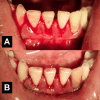Evaluating the Analgesic, Hemostatic, and Antimicrobial Potential of a Novel Herbal Formulation for Dental Use
- PMID: 40575191
- PMCID: PMC12198925
- DOI: 10.7759/cureus.84884
Evaluating the Analgesic, Hemostatic, and Antimicrobial Potential of a Novel Herbal Formulation for Dental Use
Abstract
Background: Research has explored the individual effects of phytochemicals in dentistry. Our aim was to investigate the synergistic effect these compounds have on pulpal pain, gingival bleeding, and oral microbial populations.
Methods: A proprietary formulation consisting of tannic acid, caryophyllene, curcumin, berberine, myrcene, lignin, catechin, quercetin, gallic acid, thymol, gamma-terpinene, humulene, limonene, and thymoquinone was selected for testing. The antimicrobial effect of the solution was tested using the disc diffusion method on plaque samples cultured on tryptic soy and blood agar. The hemostatic effect of the solution was evaluated by applying it to bleeding gingival tissues during the scaling procedure and recording the time until the cessation of free-flowing blood. The analgesic effect was measured through the Visual Analogue Scale (VAS) before and after topical application of the solution to the affected tooth. Time until self-reported reduction in pain was also noted.
Results: The mean zone of inhibition of the solution on tryptic soy agar and blood agar was 20 mm and 13 mm, compared to 17 mm and 15 mm of azithromycin. Colonies of Candida, Streptococci, and Staphylococci were identified and confirmed from the culture, showing susceptibility to the solution. The mean time until complete hemostasis was 5.8 ± 0.74 seconds. The mean pain score before application of the solution was 68 ± 11.4, and after application was 22±12.6, with a P-value of <0.01. The mean time for self-reported pain reduction by patients was 38 seconds.
Conclusion: The promising results from this pilot study suggest significant therapeutic efficacy, and future in-depth investigations are recommended to fully explore the potential of this novel herbal dental formulation.
Keywords: caries; gingivitis; herbal medicine; oral health; periodontitis; phytomedicine; pulpitis; tannic acid; thymol; thymoquinone.
Copyright © 2025, Tariq et al.
Conflict of interest statement
Human subjects: Consent for treatment and open access publication was obtained or waived by all participants in this study. The ethical committee of Islamic International Dental College and Hospital issued approval IIDC/IRC/2023/004/01/012. Animal subjects: All authors have confirmed that this study did not involve animal subjects or tissue. Conflicts of interest: In compliance with the ICMJE uniform disclosure form, all authors declare the following: Payment/services info: All authors have declared that no financial support was received from any organization for the submitted work. Financial relationships: All authors have declared that they have no financial relationships at present or within the previous three years with any organizations that might have an interest in the submitted work. Other relationships: All authors have declared that there are no other relationships or activities that could appear to have influenced the submitted work.
Figures


Similar articles
-
Effectiveness and tolerability of pharmacologic and combined interventions for reducing injection pain during routine childhood immunizations: systematic review and meta-analyses.Clin Ther. 2009;31 Suppl 2:S104-51. doi: 10.1016/j.clinthera.2009.08.001. Clin Ther. 2009. PMID: 19781433
-
Chlorhexidine mouthrinse as an adjunctive treatment for gingival health.Cochrane Database Syst Rev. 2017 Mar 31;3(3):CD008676. doi: 10.1002/14651858.CD008676.pub2. Cochrane Database Syst Rev. 2017. PMID: 28362061 Free PMC article.
-
Oral morphine for cancer pain.Cochrane Database Syst Rev. 2016 Apr 22;4(4):CD003868. doi: 10.1002/14651858.CD003868.pub4. Cochrane Database Syst Rev. 2016. PMID: 27105021 Free PMC article.
-
Guided tissue regeneration for periodontal infra-bony defects.Cochrane Database Syst Rev. 2006 Apr 19;(2):CD001724. doi: 10.1002/14651858.CD001724.pub2. Cochrane Database Syst Rev. 2006. Update in: Cochrane Database Syst Rev. 2019 May 29;5:CD001724. doi: 10.1002/14651858.CD001724.pub3. PMID: 16625546 Updated.
-
Enamel matrix derivative (Emdogain) for periodontal tissue regeneration in intrabony defects. A Cochrane systematic review.Eur J Oral Implantol. 2009 Winter;2(4):247-66. Eur J Oral Implantol. 2009. PMID: 20467602
References
LinkOut - more resources
Full Text Sources
